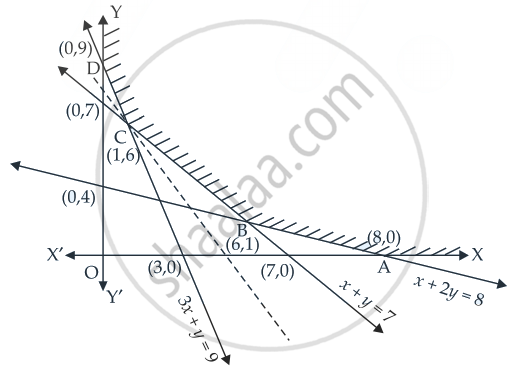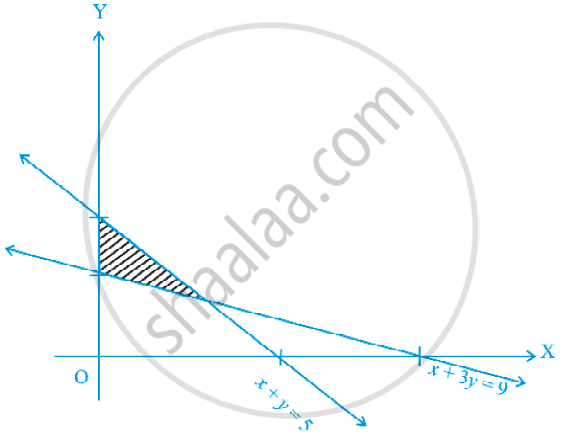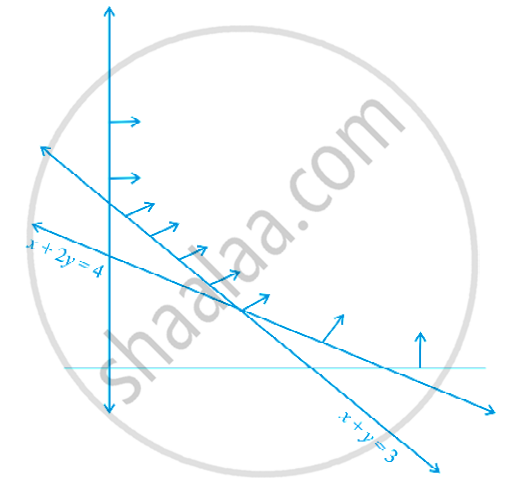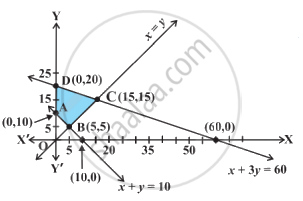Advertisements
Advertisements
Question
In order to supplement daily diet, a person wishes to take some X and some wishes Y tablets. The contents of iron, calcium and vitamins in X and Y (in milligrams per tablet) are given as below:
| Tablets | Iron | Calcium | Vitamin |
| X | 6 | 3 | 2 |
| Y | 2 | 3 | 4 |
The person needs atleast 18 milligrams of iron, 21 milligrams of calcium and 16 milligrams of vitamin. The price of each tablet of X and Y is Rs 2 and Rs 1 respectively. How many tablets of each should the person take in order to satisfy the above requirement at the minimum cost?
Solution
Let there be x units of tablet X and y units of tablet Y
So, according to the given information, we have
6x + 2y ≥ 18
⇒ 3x + y ≥ 9 ......(i)
| x | 0 | 3 |
| y | 9 | 0 |
3x + 3y ≥ 21
⇒ x + y ≥ 7 ......(ii)
| x | 0 | 3 |
| y | 9 | 0 |
2x + 4y ≥ 16
⇒ x + 2y ≥ 8 ......(iii)
| x | 0 | 8 |
| y | 4 | 0 |
x ≥ 0, y ≥ 0 ......(iv)
The price of each table of X type is ` 2 and that of y is ` 1.
So, the required LPP is
Minimise Z = 2x + y subject to the constraints
3x + y ≥ 9, x + y ≥ 7, x + 2y ≥ 8, x ≥ 0, y ≥ 0
On solving (ii) and (iii) we get
x = 6 and y = 1
On solving (i) and (ii) we get
x = 1 and y = 6
From the graph, we see that the feasible region ABCD is unbounded whose corner points are A(8, 0), B(6, 1), C(1, 6) and D(0, 9).
Let us evaluate the value of Z
| Corner points | Value of Z = 2x + y | |
| A(8, 0) | Z = 2(8) + 0 = 16 | |
| B(6, 1) | Z = 2(6) + 1 = 13 | |
| C(1, 6) | Z = 2(1) + 6 = 8 | ← Minimum |
| D(0, 9) | Z = 2(0) + 9 = 9 |
Here, we see that 8 is the minimum value of Z at (1, 6) but the feasible region is unbounded.
So, 8 may or may not be the minimum value of Z.
To confirm it, we will draw a graph of inequality 2x + y < 8 and check if it has a common point.
We see from the graph that there is no common point on the line.
Hence, the minimum value of Z is 8 at (1, 6).
Tablet X = 1
Tablet Y = 6.
APPEARS IN
RELATED QUESTIONS
Solve the following Linear Programming Problems graphically:
Minimise Z = – 3x + 4 y
subject to x + 2y ≤ 8, 3x + 2y ≤ 12, x ≥ 0, y ≥ 0.
Solve the following Linear Programming Problems graphically:
Minimise Z = 3x + 5y
such that x + 3y ≥ 3, x + y ≥ 2, x, y ≥ 0.
Solve the following Linear Programming Problems graphically:
Minimise Z = x + 2y
subject to 2x + y ≥ 3, x + 2y ≥ 6, x, y ≥ 0.
Show that the minimum of Z occurs at more than two points.
Minimise and Maximise Z = x + 2y
subject to x + 2y ≥ 100, 2x – y ≤ 0, 2x + y ≤ 200; x, y ≥ 0.
Refer to Example 9. How many packets of each food should be used to maximize the amount of vitamin A in the diet? What is the maximum amount of vitamin A in the diet?
A manufacturer makes two types of toys A and B. Three machines are needed for this purpose and the time (in minutes) required for each toy on the machines is given below:
| Type of toy | Machines | ||
| I | II | III | |
| A | 12 | 18 | 6 |
| B | 6 | 0 | 9 |
Each machine is available for a maximum of 6 hours per day. If the profit on each toy of type A is Rs 7.50 and that on each toy of type B is Rs 5, show that 15 toys of type A and 30 of type B should be manufactured in a day to get maximum profit.
A small firm manufactures necklaces and bracelets. The total number of necklaces and bracelets that it can handle per day is at most 24. It takes one hour to make a bracelet and half an hour to make a necklace. The maximum number of hours available per day is 16. If the profit on a necklace is Rs 100 and that on a bracelet is Rs 300. Formulate on L.P.P. for finding how many of each should be produced daily to maximize the profit?
It is being given that at least one of each must be produced.
The minimum value of the objective function Z = ax + by in a linear programming problem always occurs at only one corner point of the feasible region
The feasible region for a LPP is shown in Figure. Find the minimum value of Z = 11x + 7y
The feasible region for a LPP is shown in figure. Evaluate Z = 4x + y at each of the corner points of this region. Find the minimum value of Z, if it exists.
Refer to quastion 12. What will be the minimum cost?
Maximise Z = x + y subject to x + 4y ≤ 8, 2x + 3y ≤ 12, 3x + y ≤ 9, x ≥ 0, y ≥ 0.
The corner points of the feasible region determined by the system of linear constraints are (0, 0), (0, 40), (20, 40), (60, 20), (60, 0). The objective function is Z = 4x + 3y ______.
Compare the quantity in Column A and Column B
| Column A | Column B |
| Maximum of Z | 325 |
Refer to Question 27. (Maximum value of Z + Minimum value of Z) is equal to ______.
Refer to Question 30. Minimum value of F is ______.
A feasible region of a system of linear inequalities is said to be ______ if it can be enclosed within a circle.
In a LPP, the maximum value of the objective function Z = ax + by is always finite.
Based on the given shaded region as the feasible region in the graph, at which point(s) is the objective function Z = 3x + 9y maximum?

In a linear programming problem, the constraints on the decision variables x and y are x − 3y ≥ 0, y ≥ 0, 0 ≤ x ≤ 3. The feasible region:
In linear programming infeasible solutions
In linear programming, optimal solution ____________.
A maximum or a minimum may not exist for a linear programming problem if ____________.
In Corner point method for solving a linear programming problem, one finds the feasible region of the linear programming problem, determines its corner points, and evaluates the objective function Z = ax + by at each corner point. If M and m respectively be the largest and smallest values at corner points then ____________.
Maximize Z = 3x + 5y, subject to x + 4y ≤ 24, 3x + y ≤ 21, x + y ≤ 9, x ≥ 0, y ≥ 0.
Maximize Z = 7x + 11y, subject to 3x + 5y ≤ 26, 5x + 3y ≤ 30, x ≥ 0, y ≥ 0.
Maximize Z = 10 x1 + 25 x2, subject to 0 ≤ x1 ≤ 3, 0 ≤ x2 ≤ 3, x1 + x2 ≤ 5.
Z = 6x + 21 y, subject to x + 2y ≥ 3, x + 4y ≥ 4, 3x + y ≥ 3, x ≥ 0, y ≥ 0. The minimum value of Z occurs at ____________.
The feasible region for an LPP is shown shaded in the figure. Let Z = 3x - 4y be the objective function. Minimum of Z occurs at ____________.

